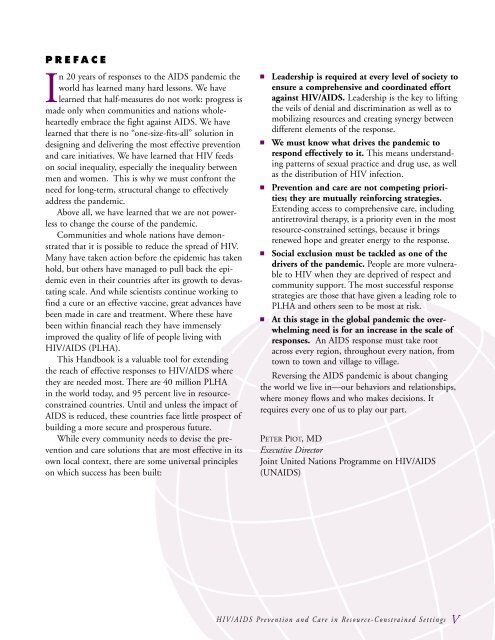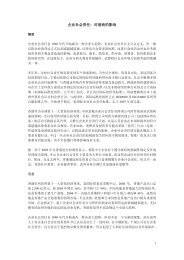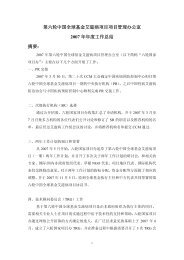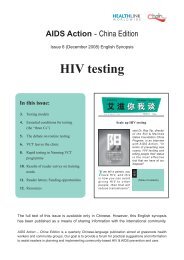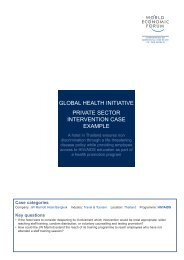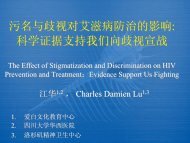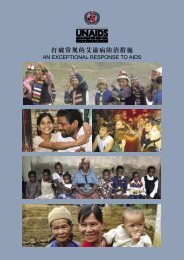X HIV/AIDS Prevention and Care in Resource-Constrained Settings
X HIV/AIDS Prevention and Care in Resource-Constrained Settings
X HIV/AIDS Prevention and Care in Resource-Constrained Settings
- No tags were found...
You also want an ePaper? Increase the reach of your titles
YUMPU automatically turns print PDFs into web optimized ePapers that Google loves.
PREFACEIn 20 years of responses to the <strong>AIDS</strong> p<strong>and</strong>emic theworld has learned many hard lessons. We havelearned that half-measures do not work: progress ismade only when communities <strong>and</strong> nations wholeheartedlyembrace the fight aga<strong>in</strong>st <strong>AIDS</strong>. We havelearned that there is no “one-size-fits-all” solution <strong>in</strong>design<strong>in</strong>g <strong>and</strong> deliver<strong>in</strong>g the most effective prevention<strong>and</strong> care <strong>in</strong>itiatives. We have learned that <strong>HIV</strong> feedson social <strong>in</strong>equality, especially the <strong>in</strong>equality betweenmen <strong>and</strong> women. This is why we must confront theneed for long-term, structural change to effectivelyaddress the p<strong>and</strong>emic.Above all, we have learned that we are not powerlessto change the course of the p<strong>and</strong>emic.Communities <strong>and</strong> whole nations have demonstratedthat it is possible to reduce the spread of <strong>HIV</strong>.Many have taken action before the epidemic has takenhold, but others have managed to pull back the epidemiceven <strong>in</strong> their countries after its growth to devastat<strong>in</strong>gscale. And while scientists cont<strong>in</strong>ue work<strong>in</strong>g tof<strong>in</strong>d a cure or an effective vacc<strong>in</strong>e, great advances havebeen made <strong>in</strong> care <strong>and</strong> treatment. Where these havebeen with<strong>in</strong> f<strong>in</strong>ancial reach they have immenselyimproved the quality of life of people liv<strong>in</strong>g with<strong>HIV</strong>/<strong>AIDS</strong> (PLHA).This H<strong>and</strong>book is a valuable tool for extend<strong>in</strong>gthe reach of effective responses to <strong>HIV</strong>/<strong>AIDS</strong> wherethey are needed most. There are 40 million PLHA<strong>in</strong> the world today, <strong>and</strong> 95 percent live <strong>in</strong> resourceconstra<strong>in</strong>edcountries. Until <strong>and</strong> unless the impact of<strong>AIDS</strong> is reduced, these countries face little prospect ofbuild<strong>in</strong>g a more secure <strong>and</strong> prosperous future.While every community needs to devise the prevention<strong>and</strong> care solutions that are most effective <strong>in</strong> itsown local context, there are some universal pr<strong>in</strong>cipleson which success has been built:■ Leadership is required at every level of society toensure a comprehensive <strong>and</strong> coord<strong>in</strong>ated effortaga<strong>in</strong>st <strong>HIV</strong>/<strong>AIDS</strong>. Leadership is the key to lift<strong>in</strong>gthe veils of denial <strong>and</strong> discrim<strong>in</strong>ation as well as tomobiliz<strong>in</strong>g resources <strong>and</strong> creat<strong>in</strong>g synergy betweendifferent elements of the response.■ We must know what drives the p<strong>and</strong>emic torespond effectively to it. This means underst<strong>and</strong><strong>in</strong>gpatterns of sexual practice <strong>and</strong> drug use, as wellas the distribution of <strong>HIV</strong> <strong>in</strong>fection.■ <strong>Prevention</strong> <strong>and</strong> care are not compet<strong>in</strong>g priorities;they are mutually re<strong>in</strong>forc<strong>in</strong>g strategies.Extend<strong>in</strong>g access to comprehensive care, <strong>in</strong>clud<strong>in</strong>gantiretroviral therapy, is a priority even <strong>in</strong> the mostresource-constra<strong>in</strong>ed sett<strong>in</strong>gs, because it br<strong>in</strong>gsrenewed hope <strong>and</strong> greater energy to the response.■ Social exclusion must be tackled as one of thedrivers of the p<strong>and</strong>emic. People are more vulnerableto <strong>HIV</strong> when they are deprived of respect <strong>and</strong>community support. The most successful responsestrategies are those that have given a lead<strong>in</strong>g role toPLHA <strong>and</strong> others seen to be most at risk.■ At this stage <strong>in</strong> the global p<strong>and</strong>emic the overwhelm<strong>in</strong>gneed is for an <strong>in</strong>crease <strong>in</strong> the scale ofresponses. An <strong>AIDS</strong> response must take rootacross every region, throughout every nation, fromtown to town <strong>and</strong> village to village.Revers<strong>in</strong>g the <strong>AIDS</strong> p<strong>and</strong>emic is about chang<strong>in</strong>gthe world we live <strong>in</strong>—our behaviors <strong>and</strong> relationships,where money flows <strong>and</strong> who makes decisions. Itrequires every one of us to play our part.PETER PIOT, MDExecutive DirectorJo<strong>in</strong>t United Nations Programme on <strong>HIV</strong>/<strong>AIDS</strong>(UN<strong>AIDS</strong>)<strong>HIV</strong>/<strong>AIDS</strong> <strong>Prevention</strong> <strong>and</strong> <strong>Care</strong> <strong>in</strong> <strong>Resource</strong>-Constra<strong>in</strong>ed Sett<strong>in</strong>gs V


